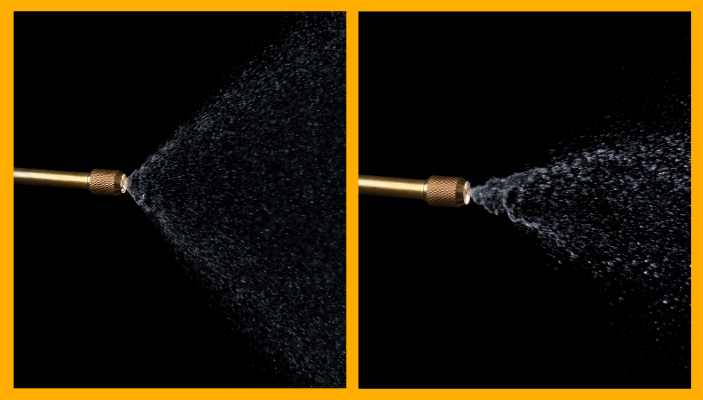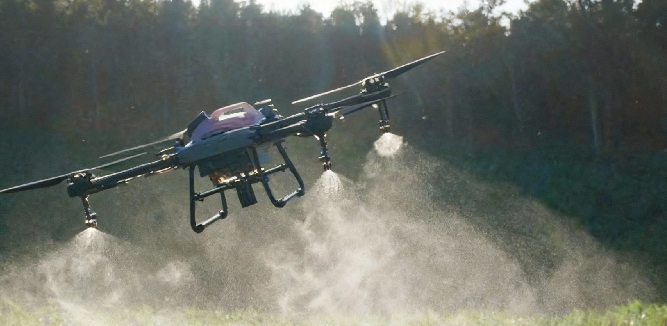“Sprayed all morning, then a gust of wind blew most of it away.”
“Even with the latest sprayer, the results didn’t meet expectations. Pests and diseases weren’t suppressed.”These are not isolated incidents, but real feedback we often hear during our communications and surveys with farmers.With the continuous development of agricultural mechanization and intelligence, self-propelled sprayers have become an essential tool for field operations. However, in actual use, spray drift frequently occurs, seriously affecting pesticide effectiveness, increasing pesticide costs, and possibly causing pesticide damage to neighboring fields or environmental pollution.
Spray drift during self-propelled sprayer operations is often caused by improper nozzle selection, excessive boom height, uncontrolled speed and pressure, or neglecting weather conditions. To effectively avoid drift, anti-drift nozzles should be used, spray parameters should be controlled, boom height should be kept stable, and equipment with intelligent control and terrain-following capabilities should be selected to achieve precise and safe agricultural spraying.
This raises the question: Is spray drift a device problem or an operational issue? In fact, it’s both. But more importantly: can we scientifically “treat the root cause” and systematically solve the problem through equipment selection, operation methods, and management strategies?
Contents
- 1 I. What Is Spray Drift, and Why Must It Be Taken Seriously?
- 2 II. Three Main Types of Spray Drift
- 3 III. How Does Self-Propelled Sprayers Work?
- 4 IV. What Are the Core Causes of Spray Drift?
- 5 V. How to Reduce Pesticide Drift During Spraying?
- 6 VI. Besides Self-Propelled Sprayers, What Other Spraying Methods Exist?
- 7 VII. Minnuo Self-Propelled Sprayers Technology: Helping You Reduce Drift from the Source
- 8 VIII. Purchasing Advice: What Kind of Self-Propelled Sprayer Is Right for You?
- 9 IX. Conclusion:
- 10 FAQ:
I. What Is Spray Drift, and Why Must It Be Taken Seriously?

Spray drift refers to the phenomenon where pesticides fail to accurately settle on the target crop surface during spraying and are instead dispersed by airflow to non-target areas.
It usually occurs within seconds after the liquid leaves the nozzle, and the drift range can span from a few meters to several dozen meters, depending on wind speed, droplet size, boom height, spray pressure, ambient humidity, and other factors.
In field operations, if spray parameters are set improperly or weather conditions are misjudged, the consequences range from ineffective spraying and increased pest outbreaks to cross-field pesticide damage, environmental disputes, or even excessive pesticide residues.
II. Three Main Types of Spray Drift
Spray drift is not a singular phenomenon and can be categorized into the following three types:
| Drift Type | Description | Common Causes |
| Evaporation Drift | Droplets evaporate into gaseous pesticides before reaching the crops due to high temperature or low humidity | Fine mist nozzles, midday heat, dry air |
| Aerosol Drift | Droplets form suspended particles during spraying and are carried away by airflow to distant areas | High-pressure spraying, strong wind, nozzle angle too high |
| Gravity Drift | Droplets sprayed from a high position deviate during descent due to wind force, failing to land accurately | Boom too high, uneven terrain, lack of terrain-adaptive control |
Tip: Among these, aerosol drift is the most common, especially under high-speed operation or windy conditions. Proper control of wind pressure, droplet size, and spray height is key to preventing drift.
III. How Does Self-Propelled Sprayers Work?
Before solving the spray drift issue, we must first understand a basic question: How does a self-propelled sprayer operate?
✔ Basic Structure of a Self-Propelled Sprayer
| Component | Function Description |
| Power System | Usually a diesel engine driving the vehicle and hydraulic system |
| Spraying System | Includes the tank, pump, pipeline, and nozzles for liquid transport and atomized spraying |
| Control System | Includes spray pressure control, nozzle switches, speed sensors, sometimes GPS and flow adjustment |
| Suspension & Boom System | Controls boom height and angle to maintain stable nozzle distance from crops |
| Terrain Adaptation System | Such as obstacle avoidance and slope adjustment devices for stable spraying on complex terrain |
✔ Operation Process (Simplified):
Farmers pre-mix the chemicals and load them into the tank
Start the engine and set spray parameters
Use GPS for path navigation according to field layout
The system automatically calculates spray volume based on speed, pressure, and nozzle spacing
Nozzles start spraying and follow the set path
Operation data is uploaded to the cloud or recorded for future tracking and management
This systematic and efficient operation is designed to achieve precision agriculture. However, due to its high level of automation, even minor deviations in one step can amplify drift issues
IV. What Are the Core Causes of Spray Drift?
1. Improper Nozzle Selection

The choice of nozzle determines droplet size — the finer the droplets, the more likely they are to drift.
Fine droplets: Better coverage but easily carried by wind
Recommendation: Use air-induction nozzles that produce large droplets with strong anti-drift capability
2. Mismatch Between Spray Pressure and Travel Speed
High pressure = fine mist: Covers more area but disperses easily in wind
High speed = high efficiency: But creates airflow disturbance and turbulence, increasing drift
Solution: Use an automatic flow control system to synchronize spray pressure with vehicle speed.
3. Spray Boom Too High
If the boom is too high above the crop, droplets stay in the air longer, increasing drift.
Recommendation: Equip the sprayer with an automatic terrain-tracking system to maintain spray height at 30–50 cm above the crop.
4. Ignoring Weather Conditions
Avoid spraying when:
Wind speed exceeds 3 m/s
Temperature exceeds 30°C
Humidity is below 40%
V. How to Reduce Pesticide Drift During Spraying?
Here is a checklist of solutions for you to follow during operations:
| Control Factor | Recommended Practice |
| Nozzle Selection | Use air-induction nozzles with large droplets; adjust types based on crop |
| Spray Pressure Control | Install an electronic flow regulation system to auto-adjust pressure based on speed |
| Operation Speed Control | Maintain 8–12 km/h; reduce speed if needed to enhance droplet deposition |
| Boom Height Adjustment | Use automatic terrain-following system to keep nozzle height at 30–50 cm |
| Spraying Time Selection | Avoid high-temperature and windy periods; spray in early morning or late afternoon |
| Record & Data Management | Use integrated tracking systems to log spray parameters for later analysis and optimization |
VI. Besides Self-Propelled Sprayers, What Other Spraying Methods Exist?

| Spraying Method | Main Equipment | Advantages | Disadvantages | Suitable Scenarios |
| Manual Backpack Sprayers | Manual or electric backpack | Low cost, suitable for small plots | Low efficiency, labor-intensive, high drift | Small orchards, home gardens |
| Tractor-Towed Sprayers | Sprayer + tractor combo | High efficiency, suitable for flat, open fields | Poor mobility, limited turning | Large field operations, regular-shaped plots |
| Drone Spraying | Multi-rotor agricultural drones | Flexible, high efficiency in complex terrain | Fine droplets, high drift risk, limited endurance | Hillsides, orchards, spot spraying |
| Fixed Sprinkler Systems | Piping + sprinkler heads | Long-term use, automated, uniform coverage | High installation cost, low flexibility | Greenhouses, turf, facility agriculture |
| Air-Blast Sprayers | Fan + pesticide-mixed nozzles | Strong penetration, ideal for dense crops | High drift risk, wind power must be well controlled | Orchards, forestry pest control |
VII. Minnuo Self-Propelled Sprayers Technology: Helping You Reduce Drift from the Source
We understand that even the best theory needs practical, reliable equipment to support it. Minnuo’s self-propelled sprayers incorporate several key technologies that can significantly help reduce the risk of spray drift:
Smart Spray Control System
Automatically adjusts nozzle pressure and flow based on travel speed
Zoned nozzle control to prevent over-spraying and missed areas
Terrain FlowTech System
Automatically detects terrain changes
Boom auto-lifts and drops to ensure consistent spray height
Anti-Drift Nozzle Configuration
All nozzles meet international drift test standards (e.g., ISO 22866)
Quick-swap design for adapting to different crop needs
☁ Cloud-Based Data Sync System
Records operation path, pesticide usage, spray timing in real time
Traceable and auditable for enhanced compliance and management
VIII. Purchasing Advice: What Kind of Self-Propelled Sprayer Is Right for You?
When choosing your equipment, pay close attention to the following key features:
Does it have an automatic pressure adjustment system?
Are anti-drift nozzles standard? Can they be swapped for different crops easily?
Is automatic nozzle height adjustment supported?
Can the control system integrate with GPS navigation and data systems?
Does the manufacturer provide training and after-sales support?
We firmly believe that buying equipment is not just about buying a machine — it’s about buying service and assurance.
IX. Conclusion:
Spray drift isn’t scary — it can be controlled, as long as you use the right methods, choose the right equipment, and apply the right technologies.
In this era of smart agricultural transformation, we hope every farmer can not only improve efficiency but also reduce loss, truly achieving “less input, more return, zero risk” in field management.
If you’re considering upgrading your spraying equipment, feel free to contact us. Our technical consultants can provide a free drift control plan tailored to your specific field.
FAQ:
1. How can you reduce spray drift?
→ Use anti-drift nozzles, control spray pressure, avoid windy or hot weather, and keep boom height stable using automatic tracking systems.
2. What should be avoided to reduce particle drift?
→ Avoid high pressure, fine droplet nozzles, high-speed spraying, and spraying during high wind speeds (over 3 m/s).
3. How does a self-propelled sprayer work?
→ It integrates power, spraying, and control systems. It autonomously adjusts spray volume and pressure according to driving speed and field conditions, guided by GPS and sensor systems.
4. What is the best time of day to spray crops?
→ Early morning (6–9 AM) or evening (5–7 PM), when wind is low and humidity is higher.
5. Do all sprayers have anti-drift features?
→ Not necessarily. Basic models may lack precision control systems. Always confirm before purchasing or upgrade with appropriate kits.

